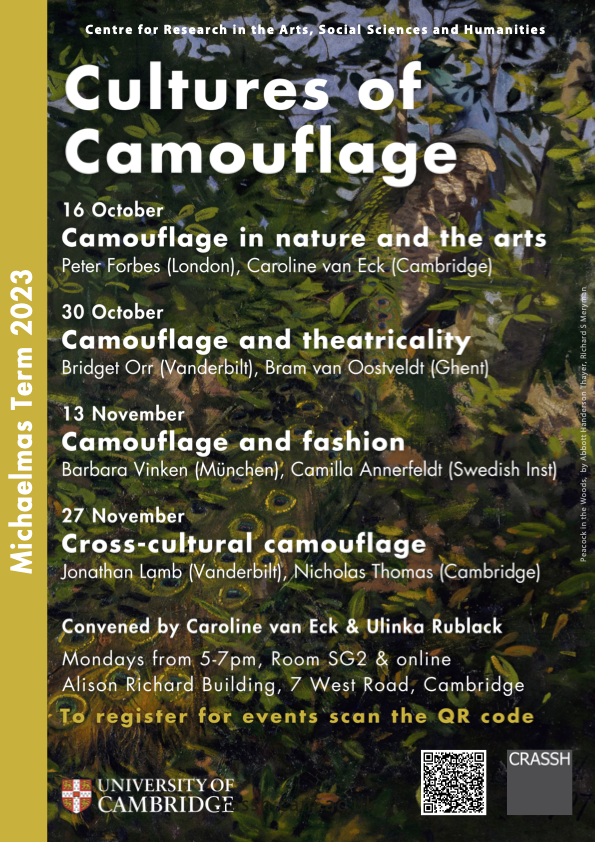Submitted by M.L. R. Grove on Tue, 10/10/2023 - 12:49
Camouflage is not the exclusive domain of animals. Humans also practice it, in hunting, war and fashion, social behaviour, and the arts. It is not restricted to artefacts; it also occurs in social behaviour, when people disguise their social status, desires, or motives behind appearances they judge to be more acceptable or effective. The shared domain of animal and human camouflage and mimicry raises many psychological, cultural, behavioural, and evolutionary questions about the relations between such animal and human behaviour, but it also offers new ways of thinking about the relations between human and other animals, the evolutionary origins of cognition, image-making, and empathy, and new departures for a dialogue between the humanities and life sciences.
Camouflage and mimicry behaviour among animals and humans has been observed and documented since Homer in the West. It received its scientific codification in the work of Bates, Wallace, and Darwin, where it served as one of the first testing grounds for the theory of survival of species through adaptation to environment. In the run-up to World War I military camouflage was much studied by artists such as Abbott Thayer, who tried to establish its principles.
Yet from the 1920s different views and perspectives began to be developed. Surrealists became very interested in it as a poetics of artistic creation. In the 1960s the novelist and entomologist Vladimir Nabokov and the Surrealist Roger Caillois independently of each other voiced a very similar criticism of evolutionist explanations of camouflage and mimicry. For Nabokov its infinite richness could not be explained by the endless hit or miss and tinkering of survival by adaptation. In Le Mimétisme Animal (1963) Caillois made the similar point that there is an excess of image-making that cannot be explained by adaptation to survive. Instead, Caillois argued, one should consider camouflage and mimicry as one manifestation of an underlying primary competence, the capacity to take something for something else, for instance to see a circle and interpret it as the eye of a dangerous animal.
These intuitions were not followed up at the time of publication, but they are now slowly finding echoes thanks to the advance of research into primary human and animal cognitive capacities. Also, in the past decades research into camouflage and mimicry was renewed because of significant advances in the knowledge of their physiology in animals.
In this network we will look at the various artistic, biological, behavioural and psychological issues raised by thinking about camouflage and mimicry as a domain of behaviour and artefacts or images shared by human and non-human animals. The network meets twice a month, on Mondays, from 5 to 7 pm, in hybrid sessions, at CRASSH. In Michaelmas the speakers are:
- 16 October: Camouflage in nature and the arts
- Prof. Caroline van Eck: Camouflage Research: A State of the Art
- Dr Peter Forbes (City University London): Drawing the World. The Art and Science of Mimicry
- 30 October: Camouflage and Theatricality
- Prof. Bridget Orr (Vanderbilt): Camouflage Labs: mimicry, disguise and presence in 18th century theatre
- Prof. Bram Van Oostveldt (Ghent): Mimicry and Camouflage in Eighteenth-Century Acting Theories
- 13 November:
- Prof. Barbara Vinken (Ludwig-Maximilians-Universität München): Camouflage and Fashion
- Dr Camilla Annerfeldt (Swedish Institute for Classical Studies Rome): A Paradise for Impostors? Clothing and Identity in Early Modern Rome
- 27 November: Cross-Cultural Camouflage
- Prof. Jonathan Lamb (Vanderbilt University): Cross-Cultural Camouflage)
- Prof. Nicholas Thomas (Museum of Archaeology and Anthropology, Cambridge)
Please go to https://www.crassh.cam.ac.uk/events/39975/ to register.
Conveners: Caroline van Eck (Department of Art History) and Ulinka Rublack (Faculty of History).

